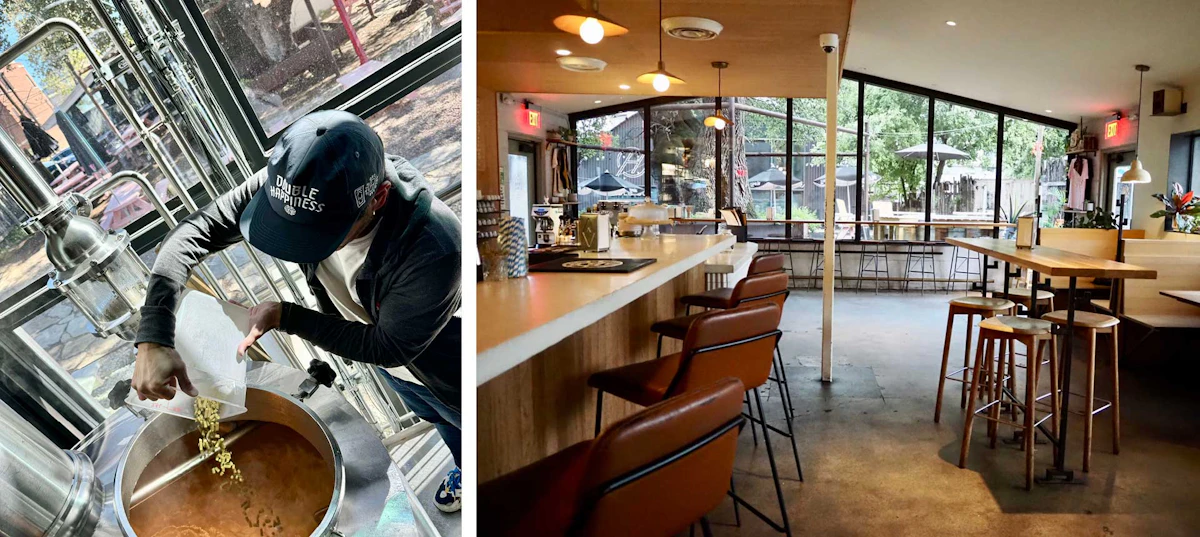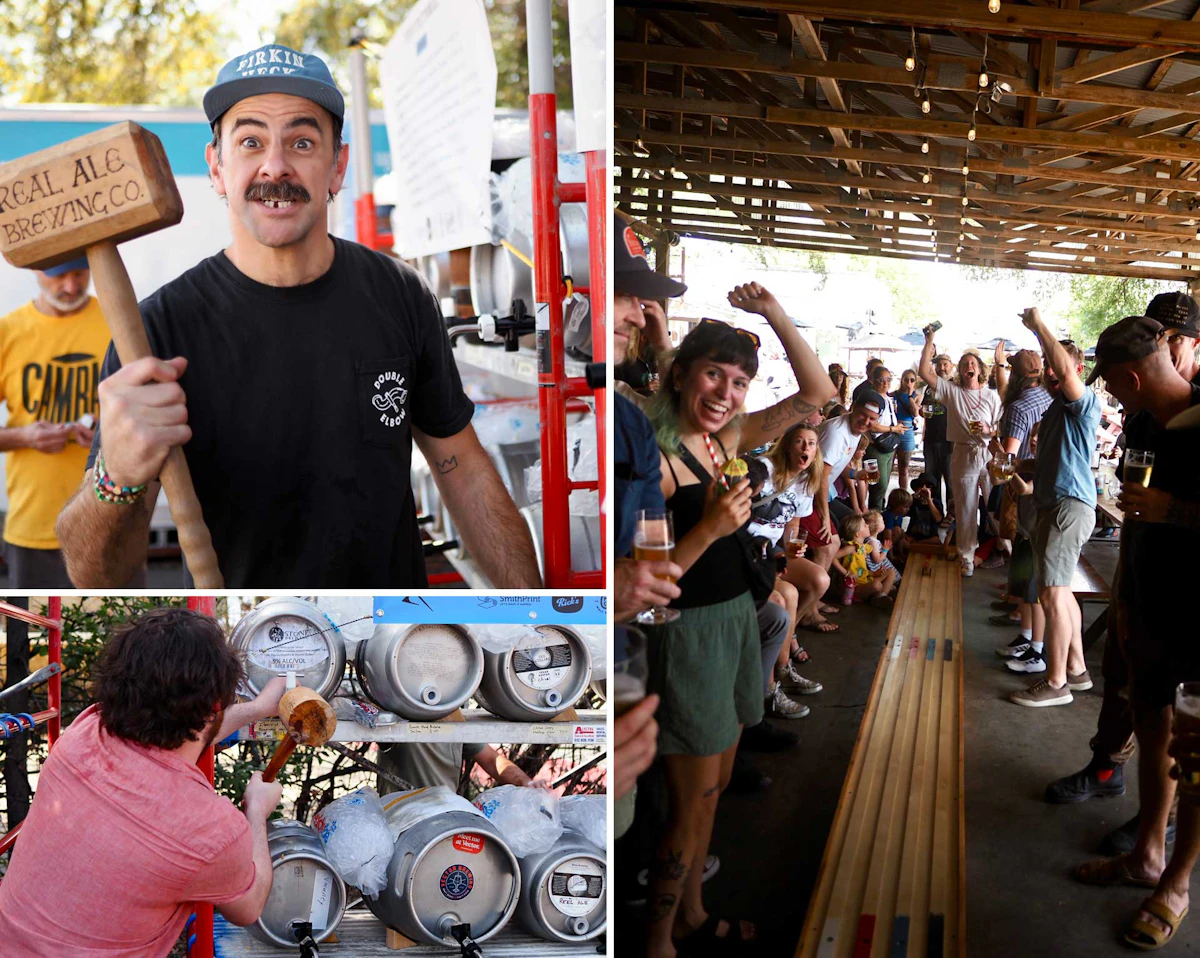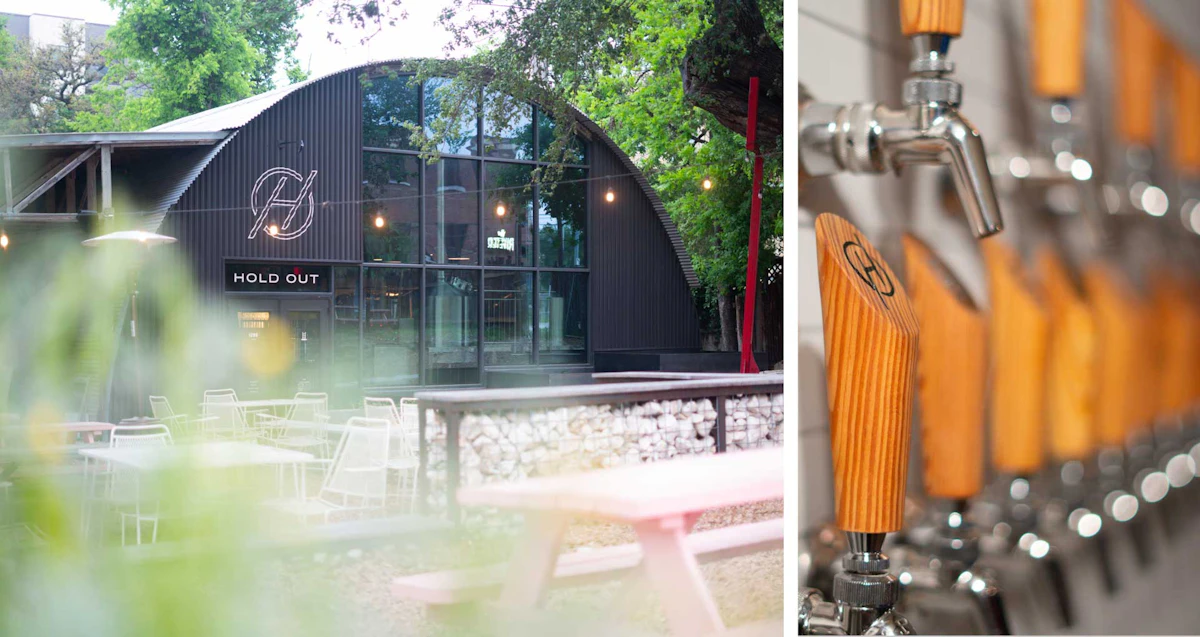Small breweries are often accelerants of change within a city or neighborhood. Austin’s Hold Out Brewing—as its name suggests—aims instead to be an agent of preservation.
For the entirety of the 2010s, Austin was annually named the fastest-growing metro area in the United States. High-rises and condominiums sprouted up at a pace that threatened to pave over what so many longtime residents and visitors loved about the city. So, in 2016, when a group of local hospitality-industry veterans first laid eyes on the shady yard and funky Quonset hut at 1208 West 4th Street, it struck them as a time capsule worth safeguarding. It was just outside downtown, but it felt worlds away from the construction boom.
At the time, the 50-year-old building was crammed with a baby grand piano, a 1965 El Camino, and various objects that ran the gamut from art piece to thrift-store detritus. Landlord Steve Ogden, who’d been using it as a private events space, had Austin roots as deep as the towering oak tree in the yard—his father had cofounded the beloved nearby honky-tonk, Donn’s Depot. As the group stood on a mezzanine overlooking his charming chaos, Ogden—apropos of nothing—began cranking AC/DC’s “Hells Bells” over the stereo.
The would-be founders of Hold Out began to nod. This place was weird—and perfect.
It would take them four more years to open the brewery. After securing the space, they found that they had to replace the block’s waterline, sewer line, and electrical transformers... then, COVID hit. The project came in two years late and doubled the initial budget, but the location was too good to relinquish.
Hold Out held out and, today, the space remains a testament to what’s always been best about Austin: a swagger that’s relaxed, quirky, and vibrant. Though the brewery just turned five, it has an old soul. At a time when drinkers can be apathetic about beer and too complacent to go out, Hold Out’s singular space draws them somewhere real and worthwhile.
“Hidden among the condos and the skyscrapers of downtown, Hold Out is a sunny, peaceful respite of the soul and individuality, of what the town is supposedly all about,” says John Gross, a DJ, longtime Austinite, cofounder of ATX Beer Party, and director of strategic business development at Next Glass.
“The taproom exudes a sense of itself,” Gross says. “The brewery is spunky, hyper-creative, and has earned its accolades over the years with banger after banger, sort of like a Southwest Missy Elliot.”
The coolest people—and breweries—look effortless to outsiders, but that belies countless calculated choices beneath the surface. Hold Out has grown to be one of the most respected of Austin’s breweries because of a series of strategic business decisions, all of which hold the physical location as a north star.

Full-Spectrum Hospitality
Like other businesses that opened during COVID’s peak, Hold Out for years struggled to find its baseline normal. Now, since the brewery’s traffic and sales have begun to normalize, the team can focus on operational moves that foster what cofounder Grady Wright calls “efficient, repeatable business.”
Efficiency—from full use of brewing capacity to dialed-in staffing—has become a greater priority as breweries’ costs have risen in recent years.
Hold Out has a special weapon in that regard: It’s a sibling business to Better Half Coffee & Cocktails, situated directly across the property from the brewery. The two share a porous patio area, and guests can freely come and go between the two. Two window walls—one at the coffeeshop/bar and one at the brewery—offer views each way. The windows, a large investment that cost in the low six figures, say something about the owners’ approach: Better Half and Hold Out work in tandem, offering a one-stop shop for diverse groups of guests while offsetting each other’s quieter periods.
For example: Better Half turned out to be an unexpectedly popular brunch destination. (The original menu didn’t even have a bloody Mary on it, but the team remedied that within the first week or two.) A fair number of brunch patrons stay on the patio to extend their day by ordering beers from Hold Out—a seamless transition that allows the courtyard to function as a one-stop shop for families, friends, tourists, and locals alike.
“When it’s a beautiful spring day in Austin and the place is jumping, you can feel it,” says Brent “Schmitty” Sapstead, Hold Out’s brewing director. “It feels pretty magical on the property.”
The benefits are clear, but so are the challenges. Operating a coffee shop, restaurant, cocktail bar, taproom, brewery, and event space all under one corporate umbrella adds massive complexity. Director of operations Mark Stowe says that collaboration among the different teams creates a positive feedback loop, with collaboration sparking new ideas and keeping teams motivated. But teams also need to be self-sufficient because no one can be everywhere at once. It’s taken time and post-COVID stability for the management team to formalize an organizational chart that’s best for operations and staff alike—a task that’s still a work in progress.
“We’ve had to teach ourselves on the fly a ton about corporate structure and leadership and accountability,” Stowe says, “how to create systems that really give people agency in their department.” Trial and error were their best teachers, he says. “It was a learning process and took a lot of willpower.” As it does other business decisions, the physical space dictates many of these choices. Keeping the property humming from sunrise to past sundown means juggling coffee and lunch service, happy-hour guests and late-night crowds. Being able to execute that complexity isn’t just useful—it’s core to why guests love Hold Out and Better Half.
“Hold Out feels like a hideaway that’s right in the thick of things,” says Meg Ellis, deputy director of the Texas Craft Brewers Guild. “It’s a place where you can go morning, noon, or night and enjoy something delightful. It’s also a great spot to meet up for groups, start an evening out, serve as a main destination, or stop in for a final [drink] at the end of the night.”

Lessons Learned, on Tap
Part of the mission to create “efficient, repeatable business” means learning from the customers who frequent Hold Out.
Every day, guests tell you what they like about your establishment, whether that’s verbal or otherwise: order tickets, occupancy per hour, even the ambivalent Untappd rating all offer valuable feedback about why customers value a certain establishment. In the case of Better Half’s popular brunch, sometimes that feedback is positive. Other times, it’s a tougher pill to swallow.
“Every so often in the brewery, we’ll be like, ‘Hey, let’s brew something Belgian,’” Sapstead says. “And the conversation usually lasts five minutes. Nope, we are never going to sell that beer.” (It’s a similar conversation for dark beers, which don’t often entice customers in the heat of an Austin summer.)
While many brewers get into this career to brew what they like to drink, that can’t always be the reality, Sapstead says. He cites the brewing adage that “you don’t get to choose your flagship.” Hold Out has been responsive to drinkers’ preferences, and they’ve found ways to successfully marry brewers’ desires with what will work in the market.
Liquid Television, the brewery’s hazy IPA, is a prime example. Originally released as a pale ale—Sapstead and Wright’s favorite style—the beer was selling decently well. At roughly 6 percent ABV, it was on the upper boundaries of American pale ale. However, when a bar called the brewery and asked whether it could begin listing Liquid Television as an IPA, Hold Out deferred. Later, the brewery decided to begin calling it an IPA, too, and sales of the beer took off.
The team realized that Austin drinkers are loyal to certain brands—such as St. Elmo’s Carl or Pinthouse’s Electric Jellyfish—and it was hard for hopheads to realize that a pale ale could be their go-to. Renaming it an “IPA”—while changing nothing else about the beer—turned it into a staple.
That’s not to say Hold Out doesn’t brew other styles. In fact, half its taps around Austin are fixed handles of Hold Out lagers (including Spudweiser, the “king of tater beers,” a medal-winning potato lager brewed in collaboration with local Live Oak). But the production schedule is about balancing creativity with adding more tally marks to the “efficient, repeatable business” column.
While the city was emerging from COVID restrictions, Sapstead was challenging his fellow brewers to come up with one new recipe per week. (“It was fun until it was not fun,” he says.) That often led to a taproom menu with too many beers on draft at once—guests were overwhelmed, and sales came at the expense of core brands. It’s a tough lesson to learn, but the data bore it out: Having more beers on draft often hindered sales. Hold Out has since dialed its menu back to about a dozen drafts at a time, down from as many as 25 at their peak.
“When the beers are on that people love and that they’re there to drink, they’re going to stay and have an extra beer versus [leaving],” Sapstead says.
Again, Hold Out’s physical home is its guiding principle. Whatever beers keep people happy and spending time on the property are the right ones—even if Sapstead would love to see a saison on draft.

Organizing for the Future
Given its operational complexity, Hold Out has experimented extensively with staff roles and company structure.
It’s gone from startup mode to something more methodical and organized, deliberately drawing management lessons from companies much larger. That means approaching leadership structure with intention, and it means creating roles suited to individuals’ talents. From front-of-house staff to upper management, it means showing that no one’s job description is set in stone. Staff burnout was, and will always remain, a real threat. Wright says that being willing to reevaluate roles helps to guard against it.
“It’s looking in the mirror, too, and saying, ‘Wait a second—is my role actually as efficient as it could be?’” Wright says. “‘Am I doing things that are not the best use of my time for the business and for everybody around me?’ And then that was kind of the aha moment.”
Though the brewery is young, Hold Out plans to stick around. The foundation of a since-demolished 75-year-old house still lays below the Quonset hut. The property’s trees have been there at least 400 years. The brewery has inherited the legacy of this particular patch of the city, and it continues to make meaning for the community that gathers there.
“In their five years of existence, I’ve got special, blurred memories of metal bands, cask fests, 1,000-person bike rides, Willie Nelson jamborees, Jell-O shots, outsider art, birthday cakes, cheesy hash-brown fries, and homies,” Gross says. “So many homies.
“Above all, it’s special to be on a property that is so fiercely ‘old Austin.’”
